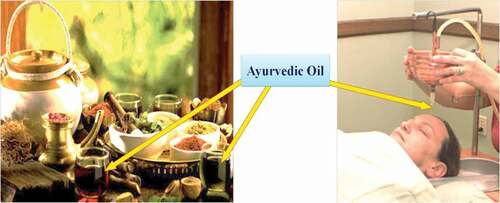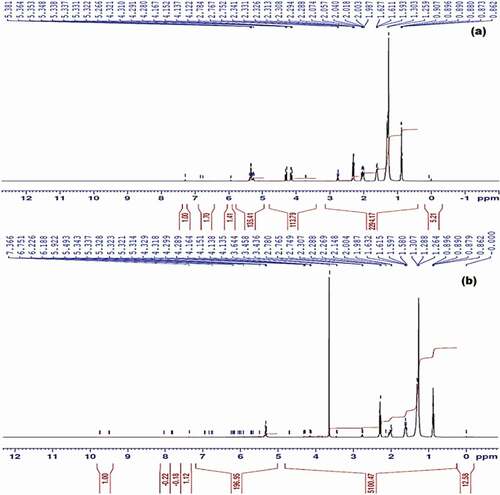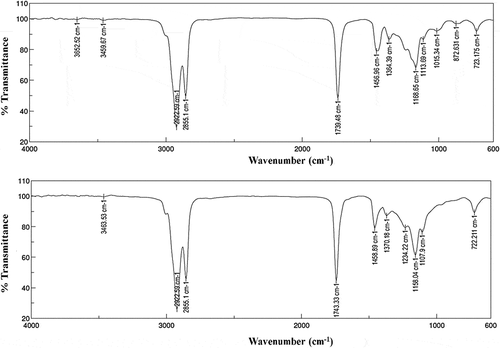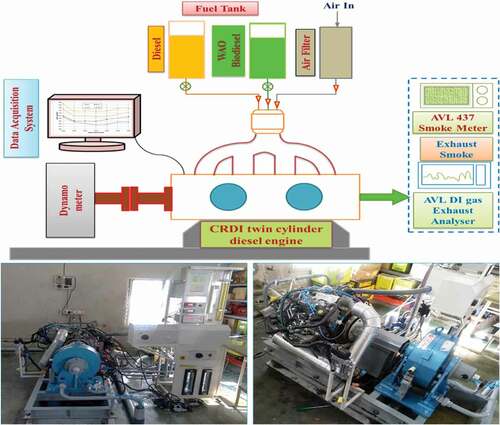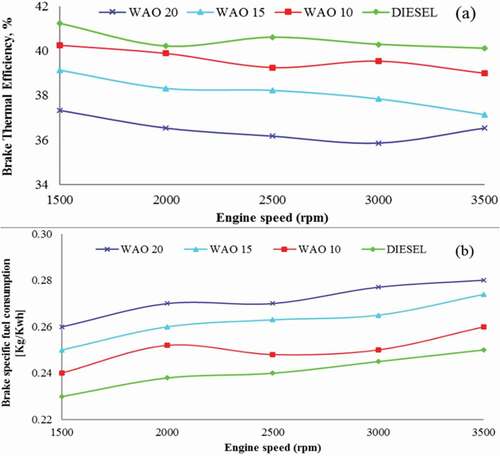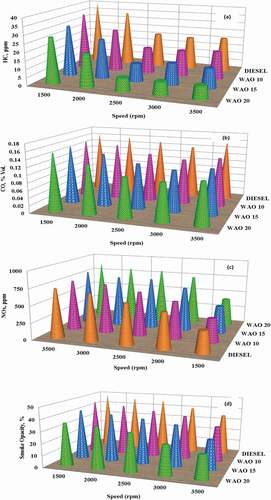ABSTRACT
Off-road diesel engines for genset applications, municipal and farming activities are the major contributors to harmful emissions. To address this, the present research reports the use of biodiesel derived from Waste Ayurvedic Oil (WAO) in an off-road twin cylinder compression ignition engine. The methyl ester of WAO was formulated using the ultrasound irradiated transesterification process. The different blends of WAO methyl ester and diesel, say WAO10, WAO15 and WAO20 were prepared and experimented on a Mahindra-Maximo twin cylinder tractor engine in order to analyse its performance, emission and combustion behaviour. As compared to diesel, WAO blends offer increased specific fuel consumption with comparable brake thermal efficiency for WAO10 over all the engine speeds. WAO10, WAO15 and WAO20 diminished CO emissions by 16.12%, 22.58% and 29.03%, HC emission by 19.04%, 42.8% and 61.9% as well as smoke opacity by 14.28%, 28.57% and 42.85% together with amplified NOx emission by 2.73%, 10.95% and 21.5% respectively in comparison with diesel. Therefore, WAO is a cost-effective feedstock for biodiesel synthesis, and its blends could be used as off-road diesel engine substitutes.
1. Introduction
The massive demand for conventional fuel sources is motivating researchers to step into the forward move on renewable energy resources, Jyothunaik and Kota (Citation2020); and Nagesh et al. (Citation2021). The alternative energy source to petroleum-based fuel is more in demand than ever, because of the policy issues, depletion and vertical price hike, as also the environmental pollution due to the toxic gases resulting in the automobile industry tightening the emission norms, Khalifeh and Esmaeili (Citation2020). Biodiesel is the most feasible alternative source to fossil fuels. However, the price of vegetable oil-based biodiesel feedstocks is quite high when compared to fossil fuels, Behzad, Mostafaei, and Mohammad Safieddin Ardebili (Citation2018); Nagarajan et al. (Citation2018). To minimise the utilisation of edible oil, widespread research has been undertaken by many researchers towards cost-effective feedstock from waste as alternative fuels such as waste cooking oil, waste chicken fat, waste fish oil, waste plastic oil, waste transformer oil and waste mango seed kernel oil.
An. et al. (Citation2013) investigated the utilisation of WCO and its blends in a multi cylinder turbocharged diesel engine incorporated with the CRDI system. They observed that the BSFC is found to have marginally improved at low speed, partial load conditions and the CO, HC and smoke emissions are drastically minimised for WCO biodiesel as compared to diesel. Masera. and Hossain (Citation2019) investigated the biodiesel mixture of cottonseed and chicken fat in a three-cylinder indirect injection diesel engine at constant speed. They noticed that the BTEs of all the mixed biodiesels (CO60CH40/CO50CH50/CO30CH70) were comparable with that of pure cotton seed oil and pure chicken fat biodiesel and 3.8% increase in NOx emission was reported with CO50CH50 as compared to diesel. Ayatallah and Mostafa (Citation2017) studied E6 Ricardo diesel engine characteristics with the use of WFO biodiesel and its blends. The use of WFO biodiesel resulted in promoting in-cylinder pressure and reduced the heat release rate as compared to diesel. Damodharan. et al. (Citation2019) made an extensive review of the utilisation of waste plastic oil extracted via pyrolysis method as diesel engine fuel. They recommended the use of WPO subjected to validate the long-term durability test of a diesel engine. Rajan et al. (Citation2020) made an attempt to assess the use of waste transformer oil in a diesel engine at different compression ratios. Arumugam et al. (Citation2020) synthesised biodiesel from waste mango seed oil using ultrasound assisted transesterifications and optimised its process parameters.
Although numerous feedstocks from waste resources are investigated for biodiesel formulation, recently attention is focussed towards the utilisation of WAO as a biodiesel resource. Ayurvedic treatments are the most active systems in human healthcare in many countries. India is the second largest player in the global ayurvedic market. In India, out of 15,000 medicinal plants, around 7000 plants are used for ayurvedic treatment.
Some of the medicinal ingredients used for ayurvedic treatment are Punarnava, Mudgaparni, Mudgaparni, Devadaru, Mashaparni, Vacha, Patala, Bilva, Ela, Prishnaparni, Ashwagandha, Paribhadra and Shyonaka. However, depending upon the type of treatment and disease, the medicinal ingredients and their proportion vary. The policies and guidelines were formed by the Department of AYUSH about the quantity of ingredients to be used for treatment and proper disposal method to handle medicated wastes. In treatments like thailadhara and shirodhara, around 40% of the used ayurvedic oil is getting wasted. It is quite difficult to dispose the used ayurvedic oil and the disposal may affect the growth of the plants, and trees, and transform the ground water into a non-drinkable one and more over it is an expensive waste management system, Singh and Kaur (Citation2012); and Kumar et al. (Citation2015).
As per the annual report by the Government of India, Ministry of Ayurveda, Yoga, Unani, Siddha and Homoeopathy (AYUSH), there were 15,193 ayurvedic dispensaries and 753 ayurvedic hospitals with a total bed strength of 35,182. Approximately 64,000 litres per day of used healing oil is disposed of into the environment and this quantity has increased every year and its disposal is of major concern for every ayurvedic hospital. Hence, a proper methodology of waste curtailment and the promotion of recycling of used healing oil is to be identified as a waste management strategy. Generally, the ayurvedic hospitals supplied the used healing oil free of cost or at minimum cost of 5/litre for immediate disposal.
In this context, we initiated the synthesis of biodiesel from WAO and conducted the performance/emission study on a single cylinder diesel engine at various injection pressures, Balakumar., Sriram, and Arumugam (Citation2019). The results exposed that, at 200 bar injection pressure, the BTE was about 36.61% and 36.27% for diesel and WAO20 respectively. Balakumar et al. (Citation2018); Balakumar, Sriram, and Arumugam (Citation2018a); Balakumar, Sriram, and Arumugam (Citation2018b), authenticated the tribological effectiveness of WAO biodiesel by using a fourball/pin-on-disc/HFRR tribometer. Rajan, Robin, and Vandanarani (Citation2019) introduced the various techniques in health care waste management system, such as the usage of effective micro-organisms and solar energy in ayurveda medical waste. shows the constituents of ayurvedic oil.
Apart from this, several investigations reported the utilisation of various biodiesels say blended kapok/moringa, Sanjid et al. (Citation2016), blended pyrolysis oil/WCO, Hossain. et al. (Citation2013), blended pine oil/soapnut oil, Venkatesan. and Nallusamy (Citation2020), moringa oleifera, Mofijur. et al. (Citation2014), rubber seed oil, Ibrahim et al. (Citation2018) in an off-road multi cylinder diesel engine. Samaras and Zierock (Citation1995) investigated and compared the pollutants of on-road and off-road diesel engines. They considered various emissions, such as the oxides of nitrogen (NOx), volatile organic compounds (VOC), carbon monoxide (CO) and particulate matter (PM) for their comparison and reported that, NOx of 14.36 g/kWh; VOC of 2.913 g/kWh; CO of 6.429 g/kWh; PM of 1.806 g/kWh were observed for on-road diesel engines, whereas for off-road diesel engines, the respective emissions are NOx of 2.73 g/kWh; VOC of 0.59 g/kWh; CO of 1.3 g/kWh; PM of 0.43 g/kWh.
Although the effects of various biodiesel on on-road multi cylinder diesel engines have been reported in the literatures, to our knowledge the performance behaviour of off-road multi cylinder diesel engine fuelled by WAO biodiesel is not reported. On-road multi cylinder engines are considered as prime sources of environmental pollution and hence not much attention is focused on off-road engines. Hence, the care taken to diminish emissions from off-road engines are still limited. Hence, the present experimental approach deals with the prospects of using WAO biodiesel and its blends on an off-road twin cylinder tractor engine. The WAO biodiesel was formulated via the ultrasound supported transesterification process and the optimum blend of WAO biodiesel (WAO10, WAO15 and WAO20) was experimented with in a Mahindra Maximo twin cylinder tractor engine to monitor the engine combustion, performance and emission attributes.
2. Experimental
2.1. Formulation of WAO methyl ester
WAO is collected from various ayurvedic hospitals, Kerala, India. WAO was filtered by using a double layered cheese cloth so as to remove solid precipitates and other foreign matters. WAO may also contain water particles. The existence of water in WAO may lead to the hydrolysis reaction of WAO methyl esters which inturn promotes the acid value of ester and saponification. The saponification reaction adversely affects the separation of ester from glycerine. To avoid this, WAO was heated to 100°C for 10 min. Analytic grade methanol, Ba(OH)28H2O-hetrogeneous catalyst, HCl and Na2SO4 were purchased from Sigma-Aldrich. The formulation of WAO methyl ester was carried out at CSIR Lab, Chennai using a 1-L four necked glass reactor facilitated with the reflux condenser and thermometer. An ultrasonic sonicator, (Branson, USA, operation frequency-20 KHz; power-400 W) was used to provide ultrasound energy. The technical details of the WAO methyl ester formulation process is listed in . The measured quantity of Ba(OH)28H2O, a heterogeneous catalyst and methanol were fed into the reactor so as to avoid the absorption of moisture. The desired amount of WAO oil was supplied to the reactor and then ultrasound energy was applied to the reaction mixture at the desired frequency and power.
Table 1. Technical details of the WAO methyl ester formulation process
After 20 min, the product was transferred to a separating funnel for 10 hours in order to separate the by-product (glycerine) and WAO methyl ester (biodiesel). Before the characterisation of biodiesel, the obtained methyl ester was purified by adopting steps followed in our reported study, Balakumar., Sriram, and Arumugam (Citation2019). Using a homogeniser, the required biodiesel blend was prepared on a volume basis viz., WAO10, WAO15 and WAO20. shows the properties of the WAO biodiesel blends.
Table 2. Properties of WAO biodiesel blends [14]
2.2. Characterisation of WAO biodiesel using FT-IR and 1H-NMR
To examine the completion of the ultrasound supported transesterification reaction, synthesised WAO methyl ester (biodiesel) was characterised using an FTIR spectrometer (JASCO, FTIR-4700, Easton) and 1H-NMR (Bruker, Avance III HD, 400 MHz narrow bore FT-NMR spectrum, Switzerland). The formulations were liquified in CDCl3 solution and then transferred to an NMR tube. shows the 1H-NMR spectra of waste ayurvedic oil and waste ayurvedic oil methyl ester. It is noticed from ) that, the existence of a peak at 3.644 corresponds to methoxy proton (-OCH3), which confirmed the formation of methyl ester.
However, the same peak was absent in the case of the spectrum corresponding to waste ayurvedic oil as depicted in ). The presence of various fatty acids in WAO biodiesel confirmed by the existence of peaks at 2.0–2.8 ppm, 0.2–1.64 ppm, 0.8–0.9 ppm and 5.3–5.4 ppm corresponds to methylene proton (α-CH2), β-methyl proton (β-CH2), terminal methyl proton (-CH3) and olefinic hydrogen (-CH2) respectively.
respectively showed the FT-IR spectra which were recorded between 600 and 4000 cm−1 wavelength for waste ayurvedic oil and WAO methyl ester. The peaks observed at 1730–1750 cm−1 attributed to C = O stretching of esters and symmetric stretching of C-H were identified between 2800 and 3000 cm−1 for both oil and methyl ester spectra. The thumb print region, say the spectrum in the range of 1500–900 cm−1 permits the chemical distraction between the oil and its corresponding methyl ester.
The peak identified at 1364 cm−1 could be the sign of a glycerol group (O-CH2) in the oil structure whereas it is absent in the methyl ester spectra which ensures the completion of the transesterification reaction. The absorbance of the peaks at 1458 cm−1 and 1158 cm−1 corresponds to the asymmetric stretching of -CH3 and stretching of O-CH3 respectively presented in the methyl ester spectra only. These findings are in good harmony with other published literatures Arumugam. et al. (Citation2016); Ighose. et al. (Citation2017).
2.3. Procedure for engine test
A Mahindra Maximo twin cylinder CRDI engine was coupled with an eddy current dynamometer. shows the engine setup in schematic as well as photographic views. respectively listed the technical description of the engine/engine control system/emission analyser and error/instrument uncertainties. A computerised data acquisition system along with an automatic engine performance analysis software ‘Engine soft 8.0’ was used to capture and store the data during experimentation. The tests were executed by varying the engine speeds from 1500 rpm to 3500 rpm for the engine fuelled with diesel, 10%, 15% and 20% by volume of WAO biodiesel blend say WAO10, WAO15 and WAO20 respectively at full load condition .
Table 3. Technical description of engine
Table 4. Technical description of engine control system
During each experiment, the various emissions, such as smoke opacity, HC, NOx, CO and combustion parameters such as cylinder pressure and heat release rate were monitored in addition to the performance behaviour, such as brake thermal efficiency and brake specific fuel consumption. Each trial was repeated thrice and the average value was considered for the analysis.
3. Results and discussions
3.1. Off-road engine performance analysis
The effect of WAO biodiesel blends on off-road twin cylinder CI engine performance, such as brake thermal efficiency (BTE) and brake specific fuel consumption (BSFC) were analysed at full engine load and 1500–3500 rpm engine speeds and are shown in respectively. The results were compared with no-2 diesel under the same engine operating conditions.
As depicted in ), the BTE is reduced marginally at higher engine speed for all the tested fuels because of the higher frictional losses. The WAO biodiesel blends offer lower BTE than no-2 diesel. Further, WAO biodiesel blends WAO10, WAO15 and WAO20 reduced the BTE by 2.37%, 5.11 and 9.48% at 1500 rpm as compared with no-2 diesel. This reduction in BTE is largely influenced by the lower calorific value of higher WAO biodiesel blends as compared to no-2 diesel. The lower viscosity and increased volatile nature of WAO10 as compared to WAO15, WAO20 might be the proper reason for higher BTE among the various WAO blends. This indicates that the fuel atomisation of WAO10 is better than that of WAO15 and WAO20. Ong et al. (Citation2014) supported this result trend and concluded that, CIB10 yielded better thermal efficiency than CIB20, CIB30 and CIB50. ) shows the BSFC trend of WAO10, WAO15, WAO20 and no-2 diesel for the engine speed of 1500–3500 rpm. At lower engine speeds, WAO10 offers reasonable BSFC of 0.24 Kg/kWh in comparison with WAO15 and WAO20 for which BSFC is 0.25 Kg/kWh and 0.26 Kg/kWh respectively. Comparatively WAO20 showed higher BSFC than WAO10 and WAO15. WAO20 has quite a lower heat of vaporisation than WAO10 and WAO15, which influences the combustion and as well as BSFC. It can be noticed that BSFC increases steadily from 1500–3500 rpm for all the fuels investigated. An increase in engine speed, rapidly promotes the frictional power which leads to a gradual increase in engine brake power than fuel consumption resulting in a slight increase in BSFC. This BSFC trend indicated that, WAO10 is the optimal blend for producing better engine torque with lower BSFC as compared with other WAO blends. Ong et al. (Citation2014) substantiated this BSFC trend with calophyllum inophyllum biodiesel blends.
3.2. Combustion characteristics
The various combustion qualities of a twin cylinder diesel engine, such as cylinder pressure vs crank angle; cumulative heat release rate vs crank angle for diesel and WAO biodiesel blends under full load and at engine speed of 3500 rpm are presented in .
Figure 6. Combustion qualities (a) cylinder pressure vs crank angle (b) net heat release rate vs crank angle
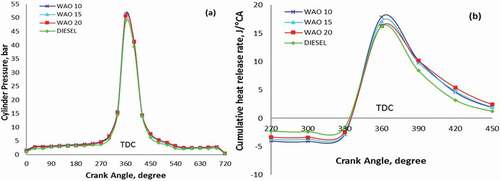
3.2.1. Pressure – crank angle behaviour
The peak cylinder pressures for diesel, WAO10, WAO15 and WAO20 were recorded as 48.93, 51.36, 50.85 and 50.62 bar respectively. For both diesel and WAO biodiesel fuels, the peak cylinder pressure was noticed at 5° crank angle after the top dead centre. It is well understood that the initial combustion stage is the predominant factor in improving peak cylinder pressure, Dattatray, and Satishchandra (Citation2011). For the WAO biodiesel blends, the peak cylinder pressure was 3.45 to 4.96 % higher than for diesel. The lower viscosity of WAO biodiesel increases the peak cylinder pressure as compared to diesel and further an increase in percentage of WAO blend beyond 20% with diesel decreases the peak cylinder pressure. The increase in percentage of the WAO blend with diesel decreases the calorific value and increases the fuel viscosity. The combustion is quite early for WAO biodiesels than for diesel. The lighter density, higher cetane number and shorter ignition delay of WAO biodiesel than diesel fuel could be the proper reason for the early combustion. The higher density of WAO biodiesel fuel denotes their increased bulk modulus. The increased bulk modulus makes WAO biodiesel incompressible and hence, WAO biodiesel blends consume lesser time and could be injected in the combustion chamber earlier than diesel fuel, which resulted in an extended premixed combustion phase and promoted peak cylinder pressure and temperature. Liu et al. (Citation2018) supported this trend and reported that the fast gassification of light molecular weight biodiesel compounds might be the reason for the improved peak cylinder pressure of biodiesel fuel than diesel.
3.2.2. Cumulative heat release rate
The cumulative heat release rate for diesel and various blends of WAO at maximum load is compared and depicted in ). The no. 2 diesel showed a lower heat release rate of 0.71 J/°CA during the initial stage of combustion, where-as in the case of WAO10, WAO15 and WAO20, the cumulative heat release rate is registered as 0.69 J/°CA, 0.85 J/°CA and 0.84 J/°CA respectively. From ) it is evident that the heat release rate curve for all WAO blends moves closer to TDC than diesel. Also, the heat release rate commences ahead for the WAO blends than diesel. The slight shifting of the heat release rate curves for WAO towards the left as compared to diesel ensured the trend of the heat release rate. Because of the early combustion and shorter ignition delay, WAO biodiesel blends finished the premixed combustion stage faster than diesel. This heat release rate trend is explained by the higher cetane number and lower volatile nature of WAO biodiesel blends than diesel: How. et al. (Citation2018).
3.3. Emission behaviour
3.3.1. Hydrocarbon (HC) emissions
HC is the resultant product of incomplete combustion of fuel and also due to the lean combustion and imperfect mixing of fuel and air inside the engine cylinder. The fuel viscosity, combustion quality, fuel spray behaviour and operating conditions of the engine blend ratio also played a major role in HC formation. The various emission characteristics of the WAO biodiesel blends and diesel fuel are shown in . The HC emissions versus various engine speeds for WAO blends are shown in ).
Over the complete speed range, HC emissions were lower than those of diesel for all the WAO blends as compared to no-2 diesel. The HC emissions were reduced by 19%, 42.8% and 61.9% for WAO10, WAO15 and WAO 20 respectively at maximum engine speed conditions. The HC emissions are noticed to be decreased when the blend percentage of WAO biodiesel is increased. The reduction in HC emission is explained by the fact that the higher percentage of WAO biodiesel increases the fuel viscosity and cetane number which augments the fuel spray behaviour and enhances air-biodiesel fuel mixing. Additionally, the higher the WAO biodiesel blend, the higher the oxygen content which promotes better combustion which in turn, reduces the HC emission
Table 5. Technical description of emission analyser
Table 6. Instrument uncertainties
Knothe, Sharp, and Ryan (Citation2006) ran a heavy duty diesel engine incorporated with a turbocharger and exhaust gas recirculation (EGR) using commercial diesel, and three neat (B100) biodiesel fuels namely methyl laurate, methyl palmitate, and methyl oleate and investigated their effects on various emissions such as HC, CO, NOx and PM. They reported that, the use of neat biodiesel along with EGR has been shown to reduce HC, CO, NOx and PM emissions at 50% load condition and 3000 rpm (medium) engine speed. Rashed et al. (Citation2016) explained that at higher speed, the mixing of air/biodiesel and combustion is better than at lower engine speed, and is responsible for reducing HC emissions.
3.3.2. Carbon monoxide (CO) emissions
The rich air-fuel ratio and low adiabatic flame temperature are the foremost reasons for CO formation. The higher CO emissions in engine specified the loss of fuel power. Besides,the engine load and speed also have an impact on the formation of CO. ) represents the variation of CO emission vs engine speed for the various WAO biodiesel blends at full engine load conditions. For the tested engine speed range, the WAO biodiesel blends showed diminished CO emissions than diesel. The CO emission is found decreased constantly up to 3000 rpm. It is noticed that at 3000 rpm engine speed, WAO10, WAO15 and WAO20 produced lower carbon monoxide emissions of 14.2%, 21.42% and 28.57% respectively than diesel. However, the CO emission is found increased when the engine speed is increased beyond 3000 rpm. At higher engine speeds, the time taken for the combustion of WAO biodiesel/diesel fuel is shorter and this promotes incomplete combustion which resulted in higher CO emissions at higher speeds. Sanjid et al. (Citation2016) observed that, at an engine speed of 3000 rpm CO emissions are decreased by 19% and 32% for KB10 and KB20 respectively than diesel. When the concentration of WAO biodiesel is increased in the diesel fuel, the higher O2 content permits more carbon to combust and facilitates complete combustion. MB10 and MB20 respectively produced 10% and 22.9% lower CO emissions than diesel Mofijur. et al. (Citation2014).
3.3.3. Oxides of nitrogen (NOx) emissions
) shows the NOx emission variation at various engine speeds at full load when using no-2 diesel and WAO biodiesel. NOx emissions are observed to be increased with an increase in engine speed and WAO biodiesel concentration in diesel fuel. The oxygen content and in-cylinder temperature are the predominant factors which influence the formation of NOx. It is seen that, at 3500 rpm WAO10, WAO15 and WAO20 produced higher NOx of about 2.7%, 10.9% and 21.5% respectively than no-2 diesel. This increase in NOx trend is authenticated by the heat release rate behaviour with the use of WAO biodiesel blends. Besides, the addition of WAO biodiesel concentration in diesel fuels promotes their viscosity and cetane number, which consequently reduces the ignition delay period and permits the fuel to stay for a longer period; i.e. prolonged residence time inside the engine cylinder which eventually accelerates the NOx formation. ) shows that, NOx increased with an increase in engine speed. This is because at higher engine speeds, the homogeneity of the air-fuel mixture is increased, which leads to better combustion and is responsible for the increase in the adiabatic flame temperature and this promotes NOx. Ozsezen and Canakci (Citation2011) investigated the use of waste palm oil methyl ester in diesel engines and reported that the larger fuel droplet size and higher viscosity of waste palm oil methyl ester is responsible for promoting NOx emission. Mani, Nagarajan, and Sampath (Citation2010) observed that, NOx emission is reduced substantially with WPO and 20% EGR level.
3.3.4. Smoke opacity
The smoke level is an indication of soot or particulate matter formation present in flue gas. ) shows the variation in smoke with engine speeds from 1500 to 3500 rpm for WAO biodiesel blends and compared to no-2 diesel. It was noted that the smoke level for WAO10, WAO15, WAO20 and diesel was 45.65%, 42%, 36% and 49.1% respectively at 1500 rpm. However, the smoke was found lower at higher engine speed. At 3500 rpm, the smoke was reduced marginally by 34.2%, 40.4%, 44.4% and 28.7% for WAO10, WAO15, WAO20 and diesel respectively as compared to that at 1500 rpm engine speed. The reason for reduced smoke opacity at higher engine speeds is the improved fuel atomisation of WAO biodiesel fuel and augmented oxidation of the soot particles. Moreover, the increase in WAO biodiesel blend decreases the smoke opacity. The reduced carbon and increased O2 content and the lack of aromatic compounds in WAO biodiesel makes combustion complete and this could be the reason for the diminished smoke opacity.
4. Conclusions
The utilisation of WAO biodiesel in an off-road twin cylinder diesel engine is investigated and based on the experimentation the following conclusions are drawn:
Ultrasonicated transesterification process could be implemented for the effective synthesis of WAO biodiesel.
WAO biodiesel blends-WAO10, WAO15 and WAO20 reduced the BTE by 2.37%, 5.11 and 9.48% at 1500 rpm as compared with no-2 diesel and the reduction in BTE is largely influenced by the lower calorific value of higher WAO biodiesel blends.
At lower engine speed, WAO10 offers reasonable BSFC of 0.24 Kg/kWh in comparison with WAO15 and WAO20 for which the BSFC is 0.25 Kg/kWh and 0.26 Kg/kWh respectively.
The peak cylinder pressure was 3.45% to 4.96% higher for the WAO biodiesel blends, than diesel. The WAO biodiesel blends consume lesser time and could be injected in the combustion chamber earlier than diesel fuel which resulted in an extended premixed combustion phase and promoted peak cylinder pressure.
HC emissions were reduced by 19%, 42.8% and 61.9% for WAO10, WAO15 and WAO 20 respectively at 3500 rpm and CO emission is found increased when the engine speed is increased beyond 3000 rpm.
At 3500 rpm and at full load condition the WAO10, WAO15 and WAO20 produced higher NOx of about 2.7%, 10.9% and 21.5% respectively than no-2 diesel.
The smoke opacity for WAO10, WAO15, WAO20 and diesel was 45.65%, 42%, 36% and 49.1% respectively at 1500 rpm and further increase in engine speed decreases the smoke emissions.
The current study ensured that the use of waste ayurvedic oil biodiesel in off-road single/twin cylinder diesel engine is scientifically feasible for economic reasons. Further research in the corrosion behaviour of various fuel injection system components may be conducted and the long-term durability test of a diesel engine influenced by waste ayurvedic oil biodiesel should be performed to promote WAO as an alternative source of fuel.
Nomenclature
ATDCAfter top dead centre
AYUSHAyurveda, Yoga and Naturopathy, Unani, Siddha, Homoeopathy
Ba(OH)28H2O Barium hydroxide
BSFCBrake specific fuel consumption
bTDCBefore top dead centre
BTEBrake thermal efficiency
CIB10Calophyllum inpophyllum-10%+diesel-90%
CIB20Calophyllum inpophyllum-20%+diesel-80%
CIB30Calophyllum inpophyllum-30%+diesel-70%
CIB50Calophyllum inpophyllum-50%+diesel-50%
CDCl3Deuterated chloroform
CICompression ignition
CO30CH70Cottonseed oil-30%+chicken fat+70%
CO50CH50Cottonseed oil-50%+chicken fat+50%
CO60CH40Cottonseed oil-60%+chicken fat-40%
COCarbonmonoxide
CRDICommon rail diesel injection
CSIRCouncil of Scientific & Industrial Research
EGRExhaust gas recirculation
HFRRHigh frequency reciprocating rig
HClHydrochloric acid
FTIRFourier-transform infrared spectroscopy
1H-NMRPhoton nuclear magnetic resonance spectroscopy
HCHydrocarbon
KB10Kapok biodiesel-10%+diesel-90%
KB20Kapok biodiesel-20%+diesel-80%
MB10Moringa biodiesel-10%+diesel-90%
MB20Moringa biodiesel-10%+diesel-80%
Na2SO4Sodium sulphate
NOxOxides of nitrogen
PMParticulate Maters
TDCTop Dead Centre
VOCVolatile Organic Compounds
WAOWaste Ayurvedic Oil
WAO1010% WAO methyl ester+90% diesel
WAO1515% WAO methyl ester+85% diesel
WAO2020% WAO methyl ester+80% diesel
WCOWaste cooking oil
WFOWaste fish oil
WPOWaste plastic oil
Disclosure statement
No potential conflict of interest was reported by the author(s).
Additional information
Notes on contributors
Balakumar Ranganathan
Balakumar Ranganathan graduated in Mechanical Engineering from Kanchi Pallavan College of Engineering (formerly called Maruthi Institute of Engineering and Technology) affiliated to Anna University, Chennai, India in the year 2005, received his Master Degree in Thermal Engineering from Sri Chandrasekharendra Saraswathi Viswa Mahavidyalaya, Enathur, Kanchipuram, India in the year 2012 and he is doing his Doctor of Philosophy (PhD.) in the field of Biodiesel from Sri Chandrasekharendra Saraswathi Viswa Mahavidyalaya, Kanchipuram, India. Currently he is working as Assistant Professor in the Department of Mechanical Engineering, Sri Chandrasekharendra Saraswathi Viswa Mahavidyalaya, Enathur, Kanchipuram, India. He has published a part of his research findings in seven International Journals. His area of interest is synthesis, tribological behavior and engine performance study using biodiesel.
Sriram Gopalasamy
Dr. Sriram Gopalasamy received his BE in Mechanical Engineering (1999) and ME in Thermal Engineering (2000) from Annamalai University, Chidambaram, India, and PhD (2006) from Sri Chandrasekharendra Saraswathi Viswa Mahavidyalaya, Kanchipuram, India. He is currently working as a Professor in the Department of Mechanical Engineering and holding a position of Dean (Engg. & Tech), Sri Chandrasekharendra Saraswathi Viswa Mahavidyalaya. He is an active member in Tribology Society of India and IEI Society. He has published over 84 national and international journals & 07 conference proceedings to his research credit. His research interest is in the field of development of bio-lubricant, biodiesel and engine oil tribology.
Arumugam Shanmugasundaram
Arumugam Shanmugasundaram graduated in Mechanical Engineering from National Engineering College, Manonmaniam Sundaranar University, Tirunelveli, India in the year 1998, received my Masters Degree in Internal Combustion Engineering from College of Engineering, Anna University, Guindy, Chennai and Doctor of Philosophy (PhD.) in the field of Bio-Lubricant from Sri Chandrasekharendra Saraswathi Viswa Mahavidyalaya, Kanchipuram, India in the year 2014. He is currently working as an Associate Professor in the Department of Mechanical Engineering, Sri Chandrasekharendra Saraswathi Viswa Mahavidyalaya, Kanchipuram, India. He has published seventy-eight research papers in International Journals which includes two book chapters and eight conference proceedings with h-index of 12. His areas of interest are Fatty acids and Optimization techniques.
References
- An., H., W. M. Yang, A. Maghbouli, J. Li, S. K. Chou, and K. J. Chua. 2013. “Performance, Combustion and Emission Characteristics of Biodiesel Derived from Waste Cooking Oils.” Applied Energy 112: 493–499. doi:https://doi.org/10.1016/j.apenergy.2012.12.044.
- Arumugam, S., C. Peddamangari Venkatesulu Reddy, T. Arulvalavan, and S. Gopalasamy. 2020. “Ultrasound Supported Synthesis of Waste Mangifera Indica Linn Biodiesel: An Optimization Using Whale Algorithm.” Energy Source Part A. Recovery, Utilization and Environmental Effect 1–15. doi:https://doi.org/10.1080/15567036.2020.1832630.
- Arumugam., S., G. Sriram, T. Rajmohan, and K. Sivakumar. 2016. “Optimization of Transesterification Process Parameters of Castor Oil Ethanolysis Using Response Surface Methodology-based Genetic Algorithm.” Energy Sources, Part A: Recovery, Utilization, and Environmental Effects 38 (2): 300–308. doi:https://doi.org/10.1080/15567036.2013.809390.
- Ayatallah, G., and M. R. H. Mostafa. 2017. “Effects of Waste Fish Oil Biodiesel on Diesel Engine Combustion Characteristics and Emission.” Renewable Energy 101: 930–936. doi:https://doi.org/10.1016/j.renene.2016.09.045.
- Balakumar., R., G. Sriram, and S. Arumugam. 2018a. “Effect of Lubricant Contaminated with Waste Ayurvedic Oil Biodiesel on Tribological Behavior of Cylinder Liner-Piston Ring Tribo Pair Material.” Materials Today: Proceedings 5 (5): 13220–13226. doi:https://doi.org/10.1016/j.matpr.2018.02.312.
- Balakumar., R., G. Sriram, and S. Arumugam. 2018b. “Assessment on Tribological Characteristics of Waste Ayurvedic Oil Biodiesel Blends Using High-Frequency Reciprocating Rig Tribometer.” IOP Conference Series: Materials Science and Engineering 390: 012047. doi:https://doi.org/10.1088/1757-899X/390/1/012047.
- Balakumar., R., G. Sriram, and S. Arumugam. 2019. “Feasibility Study of Biodiesel Synthesis from Waste Ayurvedic Oil: Its Evaluation of Engine Performance, Emission and Combustion Characteristics.” Arabian Journal for Science and Engineering 44 (9): 8067–8079. doi:https://doi.org/10.1007/s13369-019-04020-4.
- Balakumar., R., G. Sriram, S. Arumugam, and A. S. Navin. 2018. “Analysis on Tribological Characteristics of Waste Ayurvedic Oil Biodiesel Blends Using Four Ball Tribometer.” IOP Conference Series: Materials Science and Engineering 390: 012080. doi:https://doi.org/10.1088/1757-899X/390/1/012080.
- Behzad, K., M. Mostafaei, and S. Mohammad Safieddin Ardebili. 2018. “A Review on Microwave-assisted Biodiesel Production.” Energy Source Part A. Recovery, Utilization and Environmental Effect 41 (19): 2377–2395. doi:https://doi.org/10.1080/15567036.2018.1563246.
- Damodharan., D., B. R. Kumar, K. Gopal, M. V. De Poures, and B. Sethuramasamyraja. 2019. “Utilization of Waste Plastic Oil in Diesel Engines: A Review.” Reviews in Environmental Science and Bio/Technology 18 (4): 681–697. doi:https://doi.org/10.1007/s11157-019-09516-x.
- Dattatray, B. H., and V. J. Satishchandra. 2011. “Performance, Emission and Combustion Characteristic of a Multicylinder DI Diesel Engine Running on Diesel–ethanol–biodiesel Blends of High Ethanol Content.” Applied Energy 88 (12): 5042–5055. doi:https://doi.org/10.1016/j.apenergy.2011.07.008.
- Hossain., A. K., M. Ouadi, S. U. Siddiqui, Y. Yang, J. Brammer, A. Hornung, M. Kay, and P. A. Davies. 2013. “Experimental Investigation of Performance, Emission and Combustion Characteristics of an Indirect Injection Multi-cylinder CI Engine Fuelled by Blends of De-inking Sludge Pyrolysis Oil with Biodiesel.” Fuel 105: 135–142. doi:https://doi.org/10.1016/j.fuel.2012.05.007.
- How., H. G., H. H. Masjuki, Y. H. Teoh, and H. G. Chuah. 2018. “Effect of Calophyllum Inophyllum Biodiesel-diesel Blends on Combustion, Performance, Exhaust Particulate Matter and Gaseous Emissions in a Multi-cylinder Diesel Engine.” Fuel 227: 154–164. doi:https://doi.org/10.1016/j.fuel.2018.04.075.
- Ibrahim, K. A., M. R. Heikal, A. Rashid, A. Aziz, A. R. Othman, and S. Yusup. 2018. “Combustion Performance of Rubber Seed Methyl Ester Using Aromatic and Phenolic Antioxidants in a Multi-cylinder Diesel Engine.” Clean Technologies and Environmental Policy 20 (10): 2239–2253. doi:https://doi.org/10.1007/s10098-018-1601-8.
- Ighose., B. O., I. A. Adeleke, M. Damos, H. A. Junaid, K. E. Okpalaeke, and E. Betiku. 2017. “Optimization of Biodiesel Production from Thevetia Peruviana Seed Oil by Adaptive Neuro-fuzzy Inference System Coupled with Genetic Algorithm and Response Surface Methodology.” Energy Conversion and Management 132: 231–240. doi:https://doi.org/10.1016/j.enconman.2016.11.030.
- Jyothunaik, R., and T. R. Kota. 2020. “Combustion Performance and Emission Characteristics on HCCI Engine of Waste Plastic Pyrolysis Oil Biodiesel Blends with External PFI and Vaporiser.” International Journal of Sustainable Engineering 13 (3): 204–217. doi:https://doi.org/10.1080/19397038.2019.1674942.
- Khalifeh, R., and H. Esmaeili. 2020. “Biodiesel Production from Goat Fat Using Calcium Oxide Nanocatalyst and Its Combination with Diesel Fuel to Improve Fuel Properties.” International Journal of Sustainable Engineering 1–10. doi:https://doi.org/10.1080/19397038.2020.1780336.
- Knothe, G., C. A. Sharp, and T. W. Ryan. 2006. “Exhaust Emissions of Biodiesel, Petrodiesel, Neat Methyl Esters, and Alkanes in a New Technology Engine.” Energy & Fuels 20 (1): 403–408. doi:https://doi.org/10.1021/ef0502711.
- Kumar, A., S. Duggal, R. Gur, S. R. Rongpharpi, S. Sagar, M. Rani, D. Dhayal, and C. M. Khanijo. 2015. “Safe Transportation of Biomedical Waste in a Health Care Institution.” Indian Journal of Medical Microbiology 33 (3): 383–386. doi:https://doi.org/10.4103/0255-0857.158559.
- Liu, H., J. Ma, F. Dong, Y. Yang, X. Liu, G. Ma Zunqing Zheng, and M. Yao. 2018. “Experimental Investigation of the Effects of Diesel Fuel Properties on Combustion and Emissions on a Multi-cylinder Heavy-duty Diesel Engine.” Energy Conversion and Management 171: 1787–1800. doi:https://doi.org/10.1016/j.enconman.2018.06.089.
- Mani, M., G. Nagarajan, and S. Sampath. 2010. “An Experimental Investigation on a DI Diesel Engine Using Waste Plastic Oil with Exhaust Gas Recirculation.” Fuel 89 (8): 1826–1832. doi:https://doi.org/10.1016/j.fuel.2009.11.009.
- Masera., K., and A. K. Hossain. 2019. “Combustion Characteristics of Cottonseed Biodiesel and Chicken Fat Biodiesel Mixture in a Multi-Cylinder Compression Ignition Engine.” SAE Technical Paper 01-0015. DOI:https://doi.org/10.4271/2019-01-0015.
- Mofijur., M., H. H. Masjuki, M. A. Kalam, A. E. Atabani, M. I. Arbab, S. F. Cheng, and S. W. Gouk. 2014. “Properties and Use of Moringa Oleifera Biodiesel and Diesel Fuel Blends in a Multi-cylinder Diesel Engine.” Energy Conversion and Management 82: 169–176. doi:https://doi.org/10.1016/j.enconman.2014.02.073.
- Nagarajan, J., B. Narayanasamy, K. J. Kathiresh, and J. M. Solomon. 2018. “Preparation, Characterization and Effect of Calcium Carbonate and Titanium Dioxide Nano Additives on Fuel Properties of Tire Oil Diesel Blend.” Energy Source Part A. Recovery, Utilization and Environmental Effect 40 (150): 1798–1806. doi:https://doi.org/10.1080/15567036.2018.1486919.
- Nagesh, S. B., N. R. Banapurmath, T. K. Chandrashekhar, and S. V. Khandal. 2021. “Biodiesels Powered In-cylinder Common Rail Direct Injection (Crdi) Assisted Homogeneous Charge Compression Ignition (HCCI) Engine.” International Journal of Sustainable Engineering 14 (2): 147–161. doi:https://doi.org/10.1080/19397038.2020.1811012.
- Ong, H. C., H. H. Masjuki, T. M. I. Mahlia, A. S. Silitonga, W. T. Chong, and K. Y. Leong. 2014. “Optimization of Biodiesel Production and Engine Performance from High Free Fatty Acid Calophyllum Inophyllum Oil in CI Diesel Engine.” Energy Conversion and Management 81: 30–40. doi:https://doi.org/10.1016/j.enconman.2014.01.065.
- Ozsezen, A. N., and M. Canakci. 2011. “Determination of Performance and Combustion Characteristics of a Diesel Engine Fuelled with Canola and Waste Palm Oil Methyl Esters.” Energy Conversion and Management 52 (1): 108–116. doi:https://doi.org/10.1016/j.enconman.2010.06.049.
- Rajan, K., A. M. Babu, R. Paladi, S. Nallusamy, and K. R. S. Kumar. 2020. “Performance Assessment of DI Diesel Engine Using Waste Transformer Oil with Different Compression Ratios.” International Journal of Ambient Energy 1–9. doi:https://doi.org/10.1080/01430750.2020.1839548.
- Rajan, R., D. T. Robin, and M. Vandanarani. 2019. “Biomedical Waste Management in Ayurveda Hospitals-current Practices and Future Prospectives.” Journal Ayurveda Integrtive Medicine 10 (3): 214–221. doi:https://doi.org/10.1016/j.jaim.2017.07.011.
- Rashed, M. M., H. H. Masjuki, M. A. Kalam, A. Alabdulkarem, M. M. Rahman, H. K. Imdadul, and H. K. Rashedul. 2016. “Study of the Oxidation Stability and Exhaust Emission Analysis of Moringa Olifera Biodiesel in a Multi-cylinder Diesel Engine with Aromatic Amine Antioxidants.” Renewable Energy 94: 294–303. doi:https://doi.org/10.1016/j.renene.2016.03.043.
- Samaras, Z., and K.-H. Zierock. 1995. “Off-road Vehicles: A Comparison of Emissions with Those from Road Transport.” The Science of the Total Environment 169 (1–3): 249–255. doi:https://doi.org/10.1016/0048-9697(95)98123-Z.
- Sanjid, A., M. A. Kalam, H. H. Masjuki, M. Varman, N. W. B. M. Zulkifli, and M. J. Abedin. 2016. “Performance and Emission of Multi-cylinder Diesel Engine Using Biodiesel Blends Obtained from Mixed Inedible Feedstocks.” Journal of Cleaner Production 112 (5): 4114–4122. doi:https://doi.org/10.1016/j.jclepro.2015.07.154.
- Singh, A., and S. Kaur. 2012. Treatment and Disposal. Biomedical Waste Disposal, 121–122. 1st ed. New Delhi: Jaypee Brothers Medical Publishes.
- Venkatesan., V., and N. Nallusamy. 2020. “Pine Oil-soapnut Oil Methyl Ester Blends: A Hybrid Biofuel Approach to Completely Eliminate the Use of Diesel in A Twin Cylinder Off-road Tractor Diesel Engine.” Fuel 262: 116500. doi:https://doi.org/10.1016/j.fuel.2019.116500.

